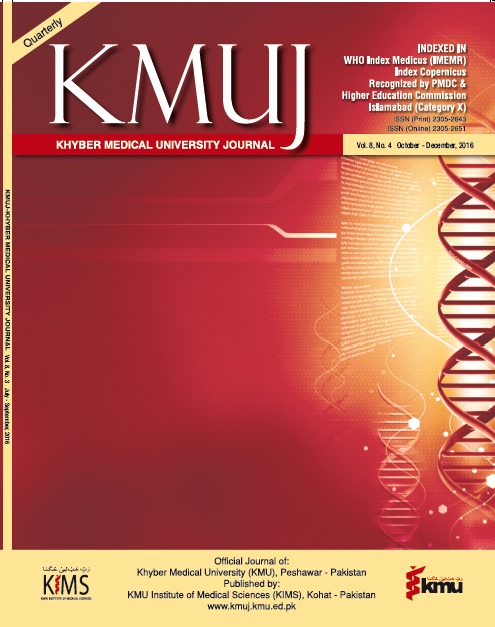EFFECTS OF UNIVERSAL EXERCISE UNIT THERAPY ON SITTING BALANCE IN CHILDREN WITH SPASTIC AND ATHETOID CEREBRAL PALSY: A QUASI-EXPERIMENTAL STUDY
Main Article Content
Abstract
OBJECTIVE: To find out improvement in sitting balance by using universal exercise unit (UEU) along with gym ball and rocker board training in children with spastic and athetoid cerebral palsy (CP).
METHODS: This study was a quasi-experimental design where 23 (15
male, 8 female) children, age 6-15 years of spastic and athetoid CP with Gross Motor Functional Classification Scale; level III were recruited during the period of 6 months. Data was recorded on trunk control measurement scale to measure sitting balance and control. UEU therapy along with gym ball and balance board training were part of the treatment protocol.
RESULTS: Out of 23 subjects, 16 (69.6%) were having spastic CP and 7 (30.4%) had Athetoid CP. The results of the study demonstrated that CP children who received therapy in UEU showed improved sitting balance after intervention of 4 weeks. While considering the components of
trunk control measurement scale (TCMS) on subscale of static sitting
balance, performance was least impaired compared to subscales of dynamic sitting balance. Mean scores of trunk control measurement scale before and after treatment were 18.35±5.81 and 21.83±5.38 respectively with p-value <0.05. Static sitting balance was 8.65±3.379 before treatment and 10.22±3.219 after treatment. Dynamic sitting balance was 5.57±3.043 & 6.91±2.695 before treatment and after treatment respectively. Dynamic reaching was 4.13±1.687 before treatment and 4.78±1.976 after treatment.
CONCLUSION: Universal exercise unit therapy bring significant improvement is sitting balance and control of CP children with spasticity and athetosis.
KEY WORDS: Cerebral palsy (MeSH); Muscle Spasticity (MeSH); Exercise Therapy (MeSH); universal exercise unit Therapy (Non-MeSH);Postural Balance (MeSH).
Article Details
Work published in KMUJ is licensed under a
Creative Commons Attribution 4.0 License
Authors are permitted and encouraged to post their work online (e.g., in institutional repositories or on their website) prior to and during the submission process, as it can lead to productive exchanges, as well as earlier and greater citation of published work.
(e.g., in institutional repositories or on their website) prior to and during the submission process, as it can lead to productive exchanges, as well as earlier and greater citation of published work.
References
Rosenbaum P, Paneth N, Leviton A, Goldstein M, Bax M, Damiano D, et al. A report: the definition and classification of cerebral palsy April 2006. Dev Med Child Neurol Suppl. 2007;109(suppl 109):8-14.
________________________________________________________________________________
Cans C. Surveillance of cerebral palsy in Europe: a collaboration of cerebral palsy surveys and registers. Dev Med Child Neurol 2000;42(12):816-24.
________________________________________________________________________________
Gajewska E, Sobieska M, Kaczmarek E, Suwalska A, Steinborn B. Achieving motor development milestones at the age of three months may determine, but does not guarantee, proper further development. Sci World J. 2013;2013:2-4.
________________________________________________________________________________
Paneth N, Hong T, Korzeniewski S. The descriptive epidemiology of cerebral palsy. Clin Perinatol. 2006;33(2):251-67.
________________________________________________________________________________
van der Heide JC, Hadders-Algra M. Postural muscle dyscoordination in children with cerebral palsy. Neural Plast. 2005;12(2-3):197-203.
________________________________________________________________________________
Butler PB. A preliminary report on the effectiveness of trunk targeting in achieving independent sitting balance in children with cerebral palsy. Clin Rehabil. 1998;12(4):281-93.
________________________________________________________________________________
Menz SM, Hatten K, Grant-Beuttler M. Strength training for a child with suspected developmental coordination disorder. Pediatr Phys Ther. 2013;25(2):214-23.
________________________________________________________________________________
Rehab4life. universal exercise unit. Available from: http://www.icrehab4life.com/#!pedia-suit-en/c1w0b.
________________________________________________________________________________
Kayihan GB, Hulya. Effectiveness of two different sensory-integration programmes for children with spastic diplegic cerebral palsy. Disabil Rehabil 2001;23(9):394-9.
________________________________________________________________________________
Aman JE, Elangovan N, Yeh I, Konczak J. The effectiveness of proprioceptive training for improving motor function: a systematic review. Front Hum Neurosci. 2014;8:1075.
________________________________________________________________________________
Bailes AF, Greve K, Schmitt LC. Changes in two children with cerebral palsy after intensive suit therapy: a case report. Pediatr Phys Ther. 2010;22(1):76-85.
________________________________________________________________________________
Nayak BK. Understanding the relevance of sample size calculation. Indian journal of ophthalmology. 2010;58(6):469.
________________________________________________________________________________
Bodkin AW, Robinson C, Perales FP. Reliability and validity of the gross motor function classification system for cerebral palsy. Pediatr Phys Ther. 2003;15(4):247-52.
________________________________________________________________________________
Palisano R, Rosenbaum P, Walter S, Russell D, Wood E, Galuppi B. Development and reliability of a system to classify gross motor function in children with cerebral palsy. Dev Med Child Neurol. 1997;39(4):214-23.
________________________________________________________________________________
Palisano RJ, Rosenbaum P, Bartlett D, Livingston MH. Content validity of the expanded and revised Gross Motor Function Classification System. Dev Med Child Neurol. 2008;50(10):744-50.
________________________________________________________________________________
Heyrman L, Molenaers G, Desloovere K, Verheyden G, De Cat J, Monbaliu E, et al. A clinical tool to measure trunk control in children with cerebral palsy: the Trunk Control Measurement Scale. Res Dev Disabil. 2011;32(6):2624-35.
________________________________________________________________________________
Jr MEG. Treatment of neuromuscular and musculoskeletal problems in cerebral palsy. Dev Neurorehabil. 2001;4(1):5-16.
________________________________________________________________________________
Bigongiari A, e Souza FdA, Franciulli PM, Neto SER, Araujo RC, Mochizuki L. Anticipatory and compensatory postural adjustments in sitting in children with cerebral palsy. Hum Mov Sci. 2011;30(3):648-57.
________________________________________________________________________________
Bar‐Haim S, Harries N, Belokopytov M, Frank A, Copeliovitch L, Kaplanski J, et al. Comparison of efficacy of Adeli suit and neurodevelopmental treatments in children with cerebral palsy. Dev Med Child Neurol. 2006;48(5):325-30.
________________________________________________________________________________
